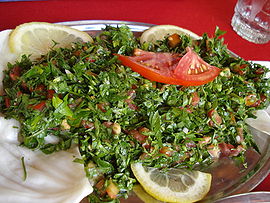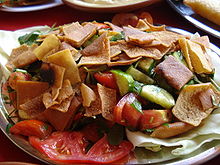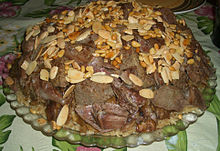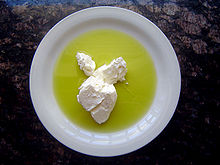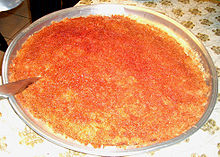- Iraqi cuisine
-
Tabbouleh, a popular Iraqi salad.

Iraqi cuisine or Mesopotamian cuisine has a long history going back some 10,000 years - to the Sumerians, Babylonians and Assyrians.[1] Tablets found in ancient ruins in Iraq show recipes prepared in the temples during religious festivals - the first cookbooks in the world.[1] Ancient Iraq, or Mesopotamia, was home to many sophisticated and highly advanced civilizations, in all fields of knowledge - including the culinary arts.[1] However, it was in the medieval era when Baghdad was the capital of the Abbasid Caliphate that the Iraqi kitchen reached its zenith.[1] Today, the cuisine of Iraq reflects this rich inheritance as well as strong influences from the culinary traditions of neighbouring Turkey, Iran and the Greater Syria area.[1]
Meals begin with appetizers and salads - known as Mezza. Some popular dishes include Kebab (often marinated with garlic, lemon and spices, then grilled), Gauss (grilled meat sandwich wrap, similar to Döner kebab), Bamia (lamb, okra and tomato stew), Quzi (lamb with rice, almonds, raisins and spices), Falafel (fried chickpea patties served with amba and salad in pita), Kubbah (minced meat ground with bulghur or rice and spices), Masgouf (grilled fish with pepper and tamarind), and Maqluba (a rice, lamb, tomato and aubergine dish). Stuffed vegetable dishes such as Dolma and Mahshi are also popular.
Contents
Iraqi cuisine
Ingredients
Some characteristic ingredients of Iraqi cuisine include:
- Vegetables such as aubergine, tomato, okra, onion, potato, courgette, garlic, peppers and chilli.
- Cereals such as rice, bulghur wheat and barley.
- Pulses and legumes such as lentils, chickpeas and cannellini.
- Fruits such as olives, dates, raisins, apricots, figs, grapes, melon, pomegranate and citrus fruits, especially lemon and lime.
- Cheeses such as baladi, feta and halloumi.
- Herbs and spices such as cinnamon, cardamom, coriander, fenugreek, cumin, oregano, saffron, baharat, sumac and za'atar.
Other Iraqi culinary essentials include butter, olive oil, tamarind, vermicelli, tahini, pistachios, almonds, walnuts, honey, date syrup, yogurt and rose water. Similarly with other countries of Western Asia, chicken and especially lamb are the favourite meats. Most dishes are served with rice - usually Basmati, grown in the marshes of southern Iraq.[1] Bulghur wheat is used in many dishes - having been a staple in the country since the days of the Ancient Assyrians.[1]
Mezza
Mezza is a selection of appetizers or small dishes often served with beverage, like anise-flavored liqueurs such as arak, ouzo, raki or different wines, similar to the tapas of Spain or finger food.
- Fried aubergine, a dish often served cold, consisting of fried aubergine with tahini sauce, lettuce, parsley and tomatoes, garnished with sumac and served on pita bread or sliced bread, often grilled or toasted. Variations include bell peppers, or a garlic lemon vinaigrette.
- Fattoush, a salad made from several garden vegetables and toasted or fried pieces of pita bread.
- Tabbouleh, a salad dish, often used as part of a mezze. Its primary ingredients are finely chopped parsley, bulgur, mint, tomato, scallion, and other herbs with lemon juice, olive oil and various seasonings, generally including black pepper and sometimes cinnamon and allspice.
- Turshi, pickled vegetables in the cuisine of many Balkan and Middle East countries. It is a traditional appetizer, meze for rakı, ouzo, tsipouro and rakia.
Dips
- Baba ghanoush, a dish of baked aubergine mashed and mixed with various seasonings.
- Hummus, a dip or spread made from cooked, mashed chickpeas, blended with tahini, olive oil, lemon juice, salt and garlic.
- Muhammara, a hot pepper dip originally from Aleppo, Syria.
- Tzatziki, an appetizer of Ottoman cuisine origin, also used as a sauce for souvlaki and gyros. Tzatziki is made of strained yoghurt (usually sheep's-milk or goat's-milk in Greece and Turkey) with cucumbers, garlic, salt, usually olive oil, pepper, dill, sometimes lemon juice and parsley, or mint added. The cucumbers are either pureed and strained, or seeded and finely diced. Olive oil, olives, and herbs are often used as garnishes.
Porridge, soups and stews
- Fasoulia, a soup of dry white beans, olive oil, and vegetables.
- Harissa, a dish similar to kashkeg that is a kind of homogeneous porridge made of previously stewed and boned chicken and coarsely ground soaked wheat.
- Lentil soup
- Margat Bamia or bamia, a stew made with okra and lamb or beef cubes and in a tomato sauce.[2]
- Kebabs, a dish consisting of grilled or broiled meats on a skewer or stick.[3] The most common kebabs include lamb and beef, although others use chicken or fish.
- Keema, a minced meat, tomato and chickpea stew, served with rice. Traditionally prepared at the annual Ashura commemorations in southern Iraq.
- Maqluba, an upside-down rice and eggplant casserole, hence the name which is literally translated as "upside-down". It is sometimes made with fried cauliflower instead of eggplant and usually includes meat - often braised lamb.[4]
- Masgouf, a traditional Iraqi dish made with fish from the Tigris.[3][5] It is an open cut freshwater fish roasted for hours after being marinated with olive oil, salt, curcuma and tamarind while keeping the skin on. Traditional garnishes for the masgouf include lime, chopped onions and tomatoes, as well as the clay-oven flatbreads common to Iraq and much of the Middle East.
- Margat Baytinijan, an eggplant (aubergine)-based dish of the Balkans and the Middle East. All versions are based primarily on sautéed eggplant and tomato, usually with minced meat.
- Pomegranate soup, called Shorbat Rumman in Iraq. It is made from pomegranate juice and seeds, yellow split peas, ground beef, mint leaves, spices, and other ingredients.[6]
- Quzi, stuffed roasted lamb.[3][5]
- Tashrib, a soup made with either lamb or chicken with or without tomatoes eaten with Iraqi nan. The bread is broken up into pieces and the soup is poured over in a big bowl.
- Tepsi Baytinijan, a very popular Iraqi casserole. The main ingredient of the dish is eggplant (baytinijan), which are sliced and fried before placing in a baking dish, accompanied with meatballs, tomatoes, onions and garlic. On top of the eggplant, Potato slices are placed on top of the mixture, and the dish is baked. Like many other Iraqi dishes it is usually served with rice, along with salad and pickles.
Dumplings and meatballs
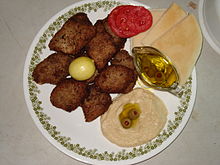 Iraqi Kibbeh served with hummus and olives.
Iraqi Kibbeh served with hummus and olives.
- Dolma, a family of stuffed vegetable dishes. The grape-leaf dolma is common. Zucchini, eggplant, tomato and pepper are commonly used as fillings. The stuffing may or may not include meat.[7]
- Falafel, a fried ball or patty made from spiced chickpeas and/or fava beans. Originally from Egypt, falafel is a popular form of fast food in the Middle East, where it is also served as a mezze.
- Kibbeh, a dish made of burghul, chopped meat, and spices. The best-known variety is a torpedo-shaped burghul shell stuffed with chopped meat and fried. Other varieties are baked, poached, or even served raw as famously done by the Lebanese. They may be shaped into balls, patties, or flat.[6]
- Kofta, a family of meatball or meatloaf dishes in Middle Eastern, Indian, and Balkan cuisines. In the simplest form, koftas consist of balls of minced or ground meat — usually beef or lamb — mixed with spices and/or onions. The vegetarian varieties like lauki kofta, shahi aloo kofta, and malai kofta are popular in India, as is kofta made of minced goat meat.
- Sarma
- Sambusak, a small fried or baked pasty, which may be either half-moon shaped or triangular. Sambusac is popular throughout Southwest Asia, the Horn of Africa, and North Africa.
Processed meat
- Pastırma, a highly seasoned, air-dried cured beef in the cuisines of the former Ottoman countries.
- Sujuk, a dry, spicy sausage eaten from the Balkans to the Middle East and Central Asia.
Rice dishes
 Iraqi Biryani
Iraqi Biryani
Rice, especially long-grain rice (timn) is staple in Iraqi cookery.[3][5]
- Biryani, a set of rice-based foods made with spices, rice (usually basmati) and meat/vegetables. It was brought to India by Muslim travellers and merchants, and is collectively popular in Iraq, Iran, Afghanistan, Pakistan, Bangladesh, India and among Muslims in Sri Lanka.
- Khichdi, a food of Indian origin made from rice and lentils. Khichdi is commonly considered to be a comfort food, and was the inspiration for the Anglo-Indian dish of Kedgeree.
- Mujaddara, a dish consists of cooked lentils together with wheat or rice, garnished with onions that have been sauteed in vegetable oil.
- Tabeet, a chicken stuffed (and buried) with (and within) rice, tomatoes, dried apricots and raisins, with a strong cardamom flavor.
Sandwiches and wraps
- Sabich, a Middle-Eastern food consisting of pita stuffed with fried eggplant and hard boiled eggs. Local consumption is said to have stemmed a tradition among Iraqi Jews, who ate it on Shabbat morning.
- Shawarma, a Middle Eastern Arabic-style sandwich-like wrap[3] usually composed of shaved lamb, goat, chicken, turkey, beef, or a mixture of meats. Shawarma is a popular dish and fast-food staple across the Middle East and North Africa.
Dairy
- Baladi cheese, a soft, white cheese originating from the Middle East. It has a mild yet rich flavor.
- Jameed, hard dry laban (yoghurt) made from sheeps' milk.
- Jibneh Arabieh, a simple cheese found all over the Middle East. It is particularly popular in the Persian Gulf area. The cheese has an open texture and a mild taste similar to Feta but less salty.
- Geimar, a creamy dairy product, similar to clotted cream, made in the Balkans, Turkey, the Middle East, Central Asia, Iran, Afghanistan, and India. It is made from the milk of water buffalos in the East or of cows in the West.
- Labaneh, yoghurt which has been strained in a cloth or paper bag or filter, traditionally made of muslin, to remove the whey, giving a consistency between that of yoghurt and cheese, while preserving yoghurt's distinctive sour taste.[6]
Breads and pastries
- Burek, a type of baked or fried filled pastry. It is made of a thin flaky dough known as phyllo dough (or yufka dough), and are filled with salty cheese (often feta), minced meat, potatoes or other vegetables.
- Ka'ak, refer to several different types of baked goods produced throughout the Arab world and the Near East.
- Kadaif, a very fine vermicelli-like pastry used to make sweet pastries and desserts.
- Kahie, layers of thin dough phyllo usually consumed warm for breakfast by adding cream Kaymak and light sugar syrup Shira[disambiguation needed
 ].
]. - Khubz, an Arabic flatbread that is part of the local diet in many countries of Western Asia.
- Laffa (an Iraqi pita or Naan bread)
- Lahmacun, a thin pizza topped with minced meat and herbs.
- Manakish, a pizza consisting of dough topped with thyme, cheese, or ground meat.
- Markook, a type of flatbread common in the countries of the Levant. It is baked on a domed or convex metal griddle, known as Saj. It is usually sizable, about 2 feet, and thin, almost transparent.
- Pita
- Samoons, flat and round bread.[5]
- Sfiha, a pizza-like dish traditionally made with ground mutton rather than the more modern addition of lamb, or beef in Brazil. They are "open faced" meat pies with no top dough. Sfiha were much like dolma; simply ground lamb, lightly spiced, wrapped in brined grape leaves.
Condiments, sauces and spices
- Amba, a tangy mango pickle condiment. Commonly eaten as a side dish and sometimes as a sandwich topping.
- Baharat, a spice mixture. Typical ingredients include: allspice, black pepper corns, cardamom seeds, cassia bark, cloves, coriander seeds, cumin seeds, nutmeg, dried red chili peppers or paprika.
- Jallab, a type of syrup popular in the Middle East made from dates, grape molasses and rose water.
- Mahlab, an aromatic spice made from the seeds of the St Lucie Cherry (Prunus mahaleb).
- Dibis, a thick, very sweet date syrup. Often mixed with tahini to create a dip.
- Rose water (Mayy Wared)
- Tahini (t'heena), a paste of ground sesame seeds used in cooking. Middle Eastern tahini is made of hulled, lightly roasted seeds.
- Za'atar, a mixture of herbs and spices used as a condiment
Desserts
 A typical Iraqi Kleicha, a national Iraqi cookie.
A typical Iraqi Kleicha, a national Iraqi cookie.
- Baklawa, a rich pastry[5] made of layers of phyllo dough filled with chopped nuts and sweetened with syrup or honey. Iraqi baklawa is a less juicy version that is cooked and presented in smaller diamond-shaped cuts flavored with rose water, which makes a perfect souvenir of the city of Yazd.
- Halva
- Kanafeh, a pastry made with layers of semolina, white cheese and a sugary syrup sprinkled with rose water.
- Kleicha, a national cookie of Iraq. Kleicha comes in several traditional shapes and fillings, the most popular being the molded ones filled with dates (kleichat tamur). The sweet discs (khfefiyyat) are also favoured along with the half moons filled with nuts and sugar (kleichat joz).
- Qatayef, an Arab dessert reserved for the Muslim holiday of Ramadan, a sort of sweet crepe filled with cheese or nuts. It was traditionally prepared by street vendors as well as households in the Levant and more recently has spread to Egypt.
Beverages
 Tea is a beloved Iraqi beverage.
Tea is a beloved Iraqi beverage.
 Iraqi tea set samawar
Iraqi tea set samawar
- Arabic coffee, an Iraq national drink that has a strong and bitter taste. The black and thick coffee is sometimes served to a guest for hospitality, as well as during funerals.[6][5]
- Arak, a clear, colourless, unsweetened aniseed-flavoured distilled alcoholic drink. Arak is usually not drunk straight, but is mixed in approximately 1/3 arak to 2/3 water, and ice is then added.
- Tea, also known as Chai, is widely consumed throughout the day, especially in the mornings, after meals, and during social settings. It is prepared in a special way involving boiling tea in hot water, then placing it over a second tea pot with boiling water to let the tea infuse. Iraqi tea is renowned for being considerably stronger, richer and sweeter than those found in neighbouring countries, and is usually brewed with cardamom (heil).
See also
References
- ^ a b c d e f g http://www.thingsasian.com/stories-photos/3592 Foods of Iraq: Enshrined With A Long History. Habeeb Salloum.
- ^ Fair, (2008) p.72
- ^ a b c d e ʻAlī Akbar Mahdī, (2003) p.40 -41
- ^ Jacob (2007) p.4
- ^ a b c d e f Taus-Bolstad, Stacy (2003) Iraq in Pictures, Twenty-First Century Books, p.55, ISBN 0822509342
- ^ a b c d Jacob (2007) p.2
- ^ Fair, (2008), p.71
Bibliography
- ʻAlī Akbar Mahdī, (2003) Teen life in the Middle East, Greenwood Publishing Group, p. 40 -41 ISBN 031331893X
- Fair, Chris (2008) Cuisines of the Axis of Evil and Other Irritating States: A Dinner Party Approach to International Relations, Globe Pequot, p. 59 - 84 ISBN 1599212862
- Goldman, Rivka (2006), Mama Nazima's Jewish-Iraqi cuisine: low-fat, low-cholesterol : cuisine, history, cultural references, and survival stories of the Jewish-Iraqi, Hippocrene Books, ISBN 0781811449
- Jacob, Jeanne; Ashkenazi, Michael. (2007) The World Cookbook for Students, Greenwood Publishing Group p. 1 - 5 ISBN 0313334552
- Nasrallah, Nawal (2003) Delights from the Garden of Eden: A Cookbook and a History of the Iraqi Cuisine, 1stBooks, ISBN 140334793X
External links
- Iraqi Food and Cuisine
- Delicious Iraqi recipes from MoTV cooking show
- Delights from the Garden of Eden - A Cookbook and History of Iraqi Cuisine
- Ancient Mesopotamian cuisine
Asian cuisine Sovereign
states- Afghanistan
- Armenia
- Azerbaijan
- Bahrain
- Bangladesh
- Bhutan
- Brunei
- Burma (Myanmar)
- Cambodia
- People's Republic of China
- Cyprus
- East Timor (Timor-Leste)
- Egypt
- Georgia
- India
- Indonesia
- Iran
- Iraq
- Israel
- Japan
- Jordan
- Kazakhstan
- North Korea
- South Korea
- Kuwait
- Kyrgyzstan
- Laos
- Lebanon
- Malaysia
- Maldives
- Mongolia
- Nepal
- Oman
- Pakistan
- Philippines
- Qatar
- Russia
- Saudi Arabia
- Singapore
- Sri Lanka
- Syria
- Tajikistan
- Thailand
- Turkey
- Turkmenistan
- United Arab Emirates
- Uzbekistan
- Vietnam
- Yemen
States with limited
recognition- Abkhazia
- Nagorno-Karabakh
- Northern Cyprus
- Palestine
- Republic of China (Taiwan)
- South Ossetia
Dependencies and
other territoriesArab Arab · Bahraini · Egyptian · Iraqi · Jordanian · Kuwaiti · Lebanese · Omani · Levantine · Palestinian · Saudi Arabian · Syrian · Emirate · YemeniIranian and Turkic Other Cuisine Regional African · Americas · Arab · Asian · Caribbean · Central Asian · Eastern European · European · Sami · Latin American · Mediterranean · Middle Eastern · North African · South Asian · West African
National Afghan · Albanian · Algerian · American · Argentine · Armenian · Australian · Austrian · Azerbaijani · Bahraini · Bangladeshi · Belarusian · Belgian · Belizean · Beninese · Bhutanese · Bolivian · Bosnia and Herzegovina · Botswanan · Brazilian · British · Bulgarian · Burkinabe · Burmese · Cambodian · Cameroonian · Canadian · Catalan · Chadian · Chilean · Chinese · Colombian · Congolese · Croatian · Cuban · Cypriot · Czech · Danish · Dutch · Ecuadorian · Egyptian · English · Equatorial Guinean · Estonian · Ethiopian · Filipino · Finnish · French · Georgian · German · Greek · Guatemalan · Honduran · Hungarian · Icelandic · Indian · Indonesian · Iranian · Iraqi · Irish · Israeli · Italian · Ivorian (Côte d'Ivoire) · Jamaican · Japanese · Jordanian · Kazakh · Korean · Kuwaiti · Lao · Latvian · Lebanese · Libyan · Lithuanian · Luxembourg · Macedonian · Malagasy · Malaysian · Maltese · Mexican · Moldovan · Mongolian · Moroccan · Native American · Nigerian · Nigerien · Norwegian · Omani · Pakistani · Palestinian · Panamanian · Peruvian · Polish · Portuguese · Qatari · Romanian · Russian · Salvadoran · Saudi Arabian · Scottish · Serbian · Sicilian · Singaporean · Slovak · South African · Spanish · Sri Lankan · Sudanese · Swazi · Swedish · Swiss · Syrian · Taiwanese · Thai · Tunisian · Turkish · Trinidad and Tobago · Ukrainian · United Arab Emirati · Uruguayan · Uzbekistan · Venezuelan · Vietnamese · Welsh · Yemeni
Historical Styles Cuisine classique · Fast food · Fusion · Haute cuisine · Immigrant · Modernist · Molecular gastronomy · Nouvelle ·
Types of food Confectionery · Dairy products · Fruit · Herbs / Spices · Meat · Vegetable
Carbohydrate staples Types of dish Technical See also
Wikimedia Foundation. 2010.

